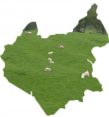Background
Both the medieval Catholic church and the Anglican church which developed after the Reformation were hierarchical organisations which created and retained many documents. These can tell you more about your parish church, its clergy and religious life in your parish. One complication is that since the 11th century Leicester Archdeaconry (which effectively covered the whole county) has been in three dioceses: Lincoln until 1837, then Peterborough until November 1926, when the diocese of Leicester (which had existed from about 680 to 886) was re-founded. Each of these dioceses were in the Province of Canterbury. Most of the documents you will need to tell you more about your church will be held at the Record Office for Leicestershire, Leicester and Rutland, but a few will be elsewhere.
Some of the original records needed to study your local church were generated by the parish, while others were created further up the ecclesiastical hierarchy, especially by the Archdeacon of Leicester. Parish records are listed in the blue binders on the shelves in the second search room at the Record Office for Leicestershire, Leicester and Rutland, but not everything there will be relevant to your research. The parish was (and is) both an ecclesiastical and a civil unit of administration and even as far back as the 16th century it was charged with responsibilities that had nothing to do with the church, such as repairing the roads. Many of the archdeaconry records are also held at the Record Office for Leicestershire, Leicester and Rutland, and have separate finding aids in binders and a card index.
Some of the most informative documents stem from the visitations of archdeacons, bishops and even occasionally archbishops. These were inspections of the clergy, churchwardens and people – whether everything was in order or whether duties were being neglected or things being done that ought not to have been done. They are therefore an essential source of information about all aspects of church life.
Unfortunately for some researchers, a number of Leicestershire parishes were (until 1858) wholly or partly within areas known as ecclesiastical peculiars, which fell outside the regular archdeaconry/diocesan structure, so archdeaconry records are unlikely to have been created. A list of villages within or partly within these peculiar jurisdictions is given at the bottom of this page.
Before delving into the records, it is worth pausing and thinking about what it is you want to find out. Are you most interested in changes to the building, or in worship, or details of the clergy, for example? Is there any particular period you are interested in?
The sources listed here have been divided into two very broad chronological periods, before 1660 and 1660 to the present day, and then by topic within that chronology. There is also a timeline of the most important religious changes and events of the 16th and 17th century which affected parish worship, and it can be useful to have this with you when looking at records. For the medieval period, the guide concentrates on those records that have been transcribed and published, and there are so many of these that only the most dedicated sleuth will feel the need to cross the barrier that the language and handwriting create for those interested in this period. Inexperienced researchers might feel most comfortable working backwards in time, gradually getting used to the older styles of writing. If you feel you need more help with the older documents, The National Archives has some online training that may assist.
The Leicestershire parishes within ecclesiastical peculiars, which may not have any of the archdeaconry records mentioned in these pages are:
Anstey, Attington, Barsby, Chadwell, Cropstone, Evington, Gaddesby, Glenfield, Grimston, Keyham, Knighton, Leicester St Margaret’s, Mountsorrel, Newtown Linford, Old Dalby, Ratby, Rothley, Saxelby, Somerby, South Croxton, Stanton under Bardon, Swithland, Wartnaby and Wycomb.
Documents for church history (1): before 1660
